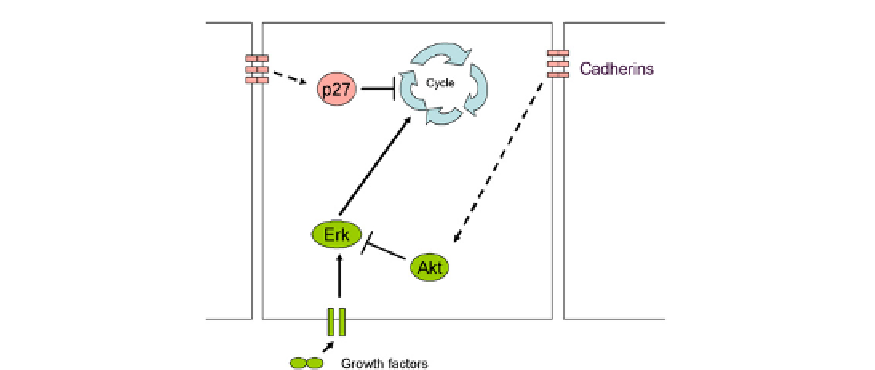Biology Reference
In-Depth Information
FIGURE 22.9
Summary of two pathways by which cell adhesion antagonizes proliferation. It is important to
note that these pathways were characterized, as much as they have been, in different cells and they may not both
operate at once. There are probably many more (see main text).
some epithelial cells, this effect is mediated by the E-cadherin cell-cell adhesion molecule
itself and, if the adhesive function of E-cadherin is inhibited using a monoclonal antibody,
intracellular levels of p27
kip1
rise.
37
Similarly, transfection of breast tumour cells with dom-
inant negative E-cadherin releases them from contact inhibition of proliferation.
38
The connection between cadherins and p27
kip1
is not yet understood, but recent work
has identified several candidate components.
37
e
41
One possibility is that the signal proceeds
via
-catenin, which is distributed through the volume of isolated cells but is localized to the
cytoplasmic domains of cell-cell junctions in cells that make contact with other cells.
41
However, the observation that antibody-mediated inhibition of E-cadherin function succeeds
in releasing contact inhibition of proliferation without, apparently, releasing
b
-catenin
from the junctions casts doubt on this.
37
The experiments were performed on different cell
types, and the discrepancy in the results may simply be a warning that different cell types
can process contact signals differently. In any case, it is very important to note that the above
paragraphs described one or two examples just to illustrate how local signals may be used to
control proliferation (
Figure 22.9
). It would be unwise to extrapolate from these to all cells,
and it is likely that many more mechanisms exist in the embryo as a whole. It is also impor-
tant to remember that a cell's propensity to proliferate also changes with differentiation, an
aspect of developmental biology that is deliberately omitted from this topic (because it is
covered so well elsewhere).
9,42
e
44
b
TISSUE-SCALE CONTROL OF PROLIFERATION: A MECHANISM FOR
KEEP
ING DIFFERENT CELL POPULATIONS IN BALA
NCE
Tissues consist of more than one type of cell, and the proportions of each type of cell gener-
ally have to be controlled within close limits if the tissue is to function properly (so do the
spatial arrangements of the cells, but this chapter focuses only on control of cell number).

